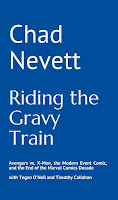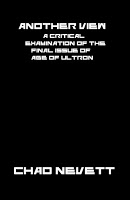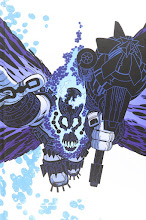 Marvels
Marvels had an odd, often forgotten effect on Marvel after its publication: the painted prestige-format books. Now, none quite lived up to
Marvels (no duh), but some were quite good. I never actually read the
Tales to Astonish one or whatever other quick one-offs they put out, but two of my favourites are, and continue to be,
Ruins and
The Last Avengers Story, both of which fall under the "Marvel Alterniverse," basically what they were calling
What If...? stories at the time. One book is a look at "what might have been," while the other is "what might yet happen," but both are very much of their time and, in their own ways, are dark comedies. Actually, they were basically published back-to-back with a cover date of August/September 1995 for
Ruins and November/December 1995 for
The Last Avengers Story. What I find odd is that one work is of the newcomer, the shit-disturber, while the other is by the seasoned professional--you would almost expected Ellis's story be the one about the future, while David's is the look back at what might have been... but it actually works better this way.
Most of us are familiar with
Ruins, which could really be described as "Warren Ellis fucks the Marvel universe," and it was recently relreased in one book, possibly killing the demand for the actual issues. I kind of wish I knew that would happen, because I will say that I fucking hate, hate, hate the way both of these books are put together. Both
Ruins and
The Last Avengers story have mostly-clear thin plastic surrounding the thick cardstock covers, and it's not a very good package. It looks nice, don't get me wrong, but it's not suited for reading. That it hasn't really appeared since these books isn't a surprise.
Ruins especially gets it bad, because it is put together like a traditional comic with stapes, while
The Last Avengers Story is square-bound, which works a little bit better. But, that was a totally uninteresting tangent...
Ruins is the dark evil twin of
Marvels. Phil Sheldon rambles through a twisted version of the Marvel universe where the Avengers are a revolutionary cell who are killed at the beginning of the first book; the remnants of a Kree invasion fleet die slowly in a radioactive concentration camp; President X lets the country rot. Really, it's pretty messed up--but in that funny sort of way.
One of the biggest complaints I've read with reference to
Ruins is that it's a bunch of scenes with little or no connection to one another strung together--and that's true, but that never really bothered me. In fact, reading this complaint made me think back to
Marvels and wonder about its structure. Yes, whole issues were devoted to a singular idea, for the most part, but wasn't it just as unfocussed and rambling in its own way? My hardcover of that series is in a box in a closet in my old room at my parents' house, so I can't do a better comparison. But, if anything, isn't
Ruins a fast-forward version of
Marvels, except about a fucked up world? Instead of going through the years, we get several days at the end--we get the recap of this dark Marvel universe... we show up in time for the death rattle... we don't bask in the glory, in the majesty... we just get the left-overs before it falls apart with Sheldon's death at the end.
One point I find very interesting is the point of divergence: the Fantastic Four's origin. In
Ruins, it's revealed that Ben Grimm never flew the shuttle and things went bad from there.
Fantastic Four #1 is the true beginning of the Marvel universe, but
Marvels actually began earlier with the creation of the Human Torch for the little prelude/prologue story... and, then, issue one dealt with the Invaders in World War II. But, while those comics were published by the company that became Marvel, they were retroactively made part of the Marvel universe (albeit very early by Lee and Kirby), and, thus, not the place where it could go wrong. I mean, there's a conscious choice there to ignore the first issue of
Marvels as a place to diverge and it points to Ellis's understanding of how the Marvel universe really is rather than how we like to make it out to be. It
really began with an insane idea about four people stealing a space shuttle and being turned into freaks as a result--an idea that could have easily been a twisted sci-fi horror comic instead of the genesis of a superhero universe. Really, that's what Ellis explores here: what if the Marvel universe was a sci-fi horror line instead of a superhero line? What if the Comics Code hadn't neutered EC? What happens if you combine what happened and what could have happened?
Maybe I'm reading too much into it, but that's what I see in
Ruins... a twisted, fucked up vision of the Marvel universe that could have easily happened had things gone a little bit differently--in a world where making a comic about four people tuned into hideous freaks by cosmic rays made more business sense than making them heroes. And, let's be honest, it could have went that way.
 The Last Avengers Story
The Last Avengers Story is a bit of a different beast as it seems less a response to
Marvels, but more a project in the similar vein. It's a celebration of the glory of the Marvel universe and a critique of the '90s darkness. The premise is quite simple: at some point in the future, the Avengers went on a tear and captured every supervillain for the government, which turned around and killed them. This caused a lot of heroes to quit, but spurred on Captain America to run for, and be elected, president. He was assassinated. Now, the Avengers are a bunch of bored, younger heroes that spend most of their time milling around their HQ--until someone blows it up. Now, Ultron 59 has challenged his father, Henry Pym to a final battle of good and evil. Ultron 59 and his Masters of Evil will fight against whatever forces Pym can gather.
David really plays into the generational nature of the story by giving us various children of heroes: Jessie, the daughter of She-Hulk and Wyatt Wingfoot is a one-woman SWAT team; the Human Torch and Alicia Masters's daughter wants nothing to do with fighting; Bombshell, the supposed daughter of Hercules; Tommy and Billy, the sons of the Vision and Scarlet Witch... one the new Grim Reaper, the other the next Sorceror Supreme. But, there are also the aging heroes: a blind Hawkeye still married to a bitter Mockingbird; a shrinking Wasp; and then, Cannonball, Pym, and Johnny Storm. Reed Richards looks after a brain-damaged Victor Von Doom. Thor, Hercules and the Thing apparently died in some apocalyptic event, while the Hulk survived only to turn evil, kill Tigra (in the infamous "Make a wish" scene) and then die with Wonder Man after punching through him. The Vision is a giant, intangible ghost, floating in the sky... and has been since a horrific event that occurred at Hank and Jan's second wedding where Wanda was killed in a run-in with Quicksilver, who then committed suicide. Peter Parker is happy, married and has a son named Ben. Susan Storm and She-Hulk "took off," but we're never given any more specifics. We don't really see any other heroes--Dr. Strange makes a brief appearance, meditating, although possibly in a vegetative state, it's hard to tell. The Masters of Evil consist of Ultron 59, Kang the Conqueror, the Grim Reaper, and Oddball, a friend and ally of the Grim Reaper. The first issue consists of Pym gathering heroes with little recaps of what's happened in the past thrown in, while the second issue is the battle.
At its heart, this is a family story--and only one family at that. David really plays up the connections between Pym, Ultron 59 and the Vision, which then brings in Billy and Tommy... really, it's about the patriarch of the Avengers, Hank Pym and his screwed up family. It's an odd way to look at the Avengers, but viewing Pym and Janet Van Dye as the father and mother of this large family oddly works. They're married, Pym created Ultron, Ultron created the Vision, the Vision married the Scarlet Witch and had two kids, the Scarlet Witch is the sister of Quicksilver--you then continue on to include the Inhumans through his marriage to Crystal, who once dated Johnny Storm, who was in the Fantastic Four at one point with She-Hulk, who is the mother of Jessie... and Quicksilver and the Scarlet Witch were mutants, which is where Cannonball comes in. Really, the Avengers team we get here is all connected to the real fight: Ultron 59 versus his dad. That's what this story is all about: father issues.
Ultron 59 hates his father, the Vision hates his father and is an absentee father, Billy and Tommy are screwed up because of their father, Bombshell never knew her father, Johnny Storm is a father struggling to make a connection with his daughter...
The key event of this story is the death of Wanda. At Hank and Jan's second wedding, Pietro's issues with the Vision, particularly jealousy, came to a head and the Vision's patience with Pietro's constant dickish behaviour was exhausted. So, they got into it, which involved Pietro running at the Vision as fast as he could, hoping his speed would prevail against the Vision's super-density. Except, Wanda stepped in front of the Vision and used her hex powers to make Pietro miss, hoping to save him--except, he saw Wanda and tried to avoid the Vision... only to slam right into Wanda, because of her hex powers, which made him run straight for her. She died, Pietro threw himself off a cliff and the Vision floated up to the clouds, leaving his two sons to their separate paths.
At the end of the fight, the Vision returns and fuses with Ultron 59 to contain the threat, but we never get any resolution concerning Billy and Tommy, last seen fighting one another. Well, actually, we see their silhouettes, watching the giant Vision/Ultron creature die, but still--their story isn't resolved. It's a lingering thread that actually bothers me quite a bit. We could assume that Billy continues as the Grim Reaper, while Tommy returns to his mystic studies, but wouldn't you imagine something more substantial? A tearful Billy ripping off his mask (made of human skin), tears streaming, finally confronting his issues with his father? The lack of resolution is problematic.
This is called
The Last Avengers Story, which is referenced twice in the actual story, at the beginning and the end. At the beginning, two years before everything else, Ultron 59 leaves a book called "The Last Avengers Story" in a time capsule that contains relics of every Marvel superhero--this book is later found by Kang, which details the battle we witness and assures his victory. Throughout the story, Ultron 59 plays the underling to Kang despite using him as a puppet in his confrontation with Pym. Where things turn is when Kang deviates from the book and kills Pym, causing Ultron 59 and the Wasp to join together to kill Kang. It's a really odd shift in Ultron 59 to go from wanting to kill Pym to avenging his death. He remarks that he never thought Kang would be arrogant enough to actually go off-script.
The title appears also at the end when it's revealed that Hawkeye and Mockingbird joined the fight only after receiving a call from Captain America, who is alive with the help of machines and has been watching, waiting. We get him at the very end, recording these events and saving them in a file titled "The Last Avengers Story."
As well, there's a small suggestion at the beginning of the story that really plays with the name "The Avengers," as Ultron 59 narrates, before blowing up the Avengers' HQ:
BEING AN AVENGERS HAS BEEN COMPARED TO BEING A MOVIE ACTOR: MOSTLY SITTING AROUND AND WAITING, PUNCTUATED BY OCCASIONAL ACTION.
THAT'S THE PROBLEM WITH HEROES, REALLY. THEIR ONLY PURPOSE IN LIFE IS TO THWART OTHERS. THEY MAKE NO PLANS, DEVELOP NO STRATEGIES. THEY REACT INSTEAD OF ACT.
WITHOUT VILLAINS, HEROES WOULD STAGNATE. WITHOUT HEROES, VILLAINS WOULD BE RUNNING THE WORLD.
HEROES HAVE MORALS. VILLAINS HAVE WORK ETHIC.
[...]
VILLAINS HIDE.
HEROES DON'T.
VILLAINS SCHEME.
HEROES WAIT.
He then follows this up by providing Pym with a chance to avenge the deaths of all of those heroes. If Ultron 59 hadn't shown up at Pym's house, there would be no clue as to who killed the Avengers. Ultron 59's attack is an indictment of superheroes.
What ties these books together is their critique of the times, of how things could go wrong. Warren Ellis'
Ruins demonstrates an alternate past and present, while Peter David's
The Last Avengers Story gives us an alternate future, mostly based on the tone of 1990s comics where having the Hulk grab Tigra by the arms and legs and pull isn't out of line. Where a confrontation between Quicksilver and the Vision killing the Scarlet Witch would be a "collector's issue with foil cover." I find it rather cool, though, that while both books were published as a result of
Marvels,
The Last Avengers Story is very much a precursor to
Kingdom Come, telling a very similar story. Hmm.
[
Both Ruins
and The Last Avengers
story can be purchased in easy-to-find collections. Ruins
in a recent book that compiles both issues, while The Last Avengers Story
is available in the hardcover Avengers: First to Last
, which collects the two-issue story as well as the back-up stories from Avengers Classic
#1-12.]
 [Okay, Tim and I talked about it and we're getting the Splash Page back on track. We let it slide a bit, but we're dedicated to a new column each week. And until Sequart is back up, we'll continue to post these columns on our blogs. So, let's get to this week's column where Tim and I actively disagree at times...]
[Okay, Tim and I talked about it and we're getting the Splash Page back on track. We let it slide a bit, but we're dedicated to a new column each week. And until Sequart is back up, we'll continue to post these columns on our blogs. So, let's get to this week's column where Tim and I actively disagree at times...]



























